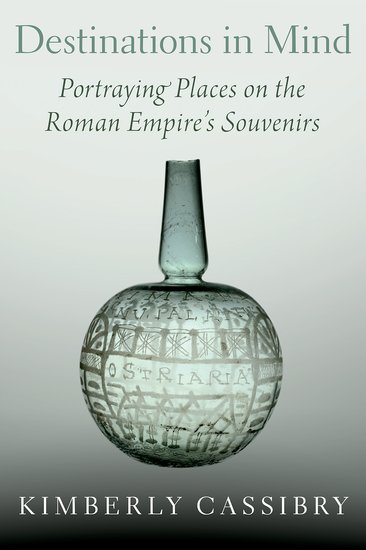
Kimberly Cassibry
Associate Professor of Art
Art and architectural historian specializing in the ancient Mediterranean.

My research focuses on the ancient Mediterranean and asks what art and architecture can tell us about international relations and the experience of empire. Interests include global art history, classical reception studies, monuments and memory, and the politics of replicating antiquities.
My book Destinations in Mind: Portraying Places on the Roman Empire's Souvenirs was published by Oxford University Press in 2021. A companion website has bonus content, links to online resources, and over a thousand photographs from my research and travels.
I am currently writing a book about my favorite empress. In Provenance and the Roman Empress: Collecting Julia Domna's Portraits, I consider why the empire's residents put this intriguing woman's face on dolls, paintings, sculptures, vessels, jewelry, and coins. I then explore the fascinating history of how these same portraits came to be in museums around the world.
Another book project focuses on my favorite landmarks. In Memorable Monuments: Designing and Transforming Triumphal Arches, I emphasize innovative features (such as bubbling fountains and zodiac archways) and unusual settings (such as soaring bridges). I also explore how these monuments have changed over time, some recycled for building materials, some destroyed for political reasons, and some reconstructed for heritage and tourism initiatives.
To create new resources for teachers and students, I am collaborating with Smarthistory (The Center for Public Art History) to broaden the site's coverage of the Roman Empire. So far, I have contributed essays on The Arch at Orange , The Roman Empire in a Connected World, Aquae Sulis, Bath, England, Julia Domna's Portraits, The Dying Gaul, Reconsidered, Hadrian's Wall, and Obelisks and Ancient Rome.
At Wellesley, my courses on the ancient Mediterranean and Mesopotamia address the political and social uses of art and architecture, as well as the modern lives of antiquities. Because seeing art in person is fundamental to understanding it, my classes analyze collections not just on campus, but also in nearby museums. They also explore and critique technologies of replication, from plaster casts to 3D prints.
I am honored to have received the 2019 Pinanski Teaching Prize and to have served as president of the college's chapter of the academic honor society Phi Beta Kappa.
Selected Publications
- "Triumphal Arches, Reception of," in The Oxford Classical Dictionary, https://doi.org/10.1093/acrefore/9780199381135.013.9035
- "Reckoning with Replication: Architectural Models, Plaster Casts, and Digital Fabrications in Rome's Recent Exhibits," MMAR 66 (2021): 184-236. http://www.jstor.org/stable/27129169
- Destinations in Mind: Portraying Places on the Roman Empire's Souvenirs (New York: Oxford University Press, 2021). https://doi.org/10.1093/oso/9780190921897.001.0001
- "The Bronze Captive in the Rhône River and Roman Art History," in Roman Sculpture in Context, eds. Anne Hrychuk Kontokosta and Peter De Staebler (Boston: Archeaological Institute of America, December 2020), 55-73
- "The Musée de la Romanité in Nîmes: The Roman Empire, Rhetorical Archaeological Museums, and UNESCOs World Heritage Program," AJA 124.1 (2020): 160-70. https://ajaonline.org/museum-review/4056
- "Spectacular Translucence: The Games in Glass", TRAJ 1 (2018). https://traj.openlibhums.org/article/id/3999
- "Reception of the Roman Arch Monument", AJA 122.2 (2018): 245-75. https://ajaonline.org//article/3621
- "Tyranny of the Dying Gaul: Confronting an Ethnic Stereotype in Ancient Art," Art Bulletin 99.2 (2017): 6-40. https://doi.org/10.1080/00043079.2017.1252647
- "Coins before Conquest in Celtic France: An Art Lost to Empire" in Beyond Boundaries: Connecting Visual Cultures in the Provinces of Ancient Rome (Los Angeles: Getty Publications, 2016), 137-155.
- "Northern Gaul, German, and Britain," in the Oxford Handbook of Roman Sculpture (New York: Oxford University Press, 2015), 471-486.
- "Honoring the Empress Julia Domna on Arch Monuments in Rome and North Africa," in Roman in the Provinces: Art on the Periphery of Empire (Chestnut Hill, MA: McMullen Museum, 2014). ark:/13960/t6vx5xb1j
Selected Talks
- "A Curious Canon: Modelling Triumphal Arches for Mussolini's Mostra Augustea," Ancient Monuments and Fascist Italy panel, AIA Chicago 2024
- "A Colonial Monument: Remembering an Ancient Triumphal Arch in France," Case Western University, 2023
- "An Obelisk, A Glass, and a Cast: Why Mobility Matters for Roman Art History," Intersections and Entanglements panel, CAA New York, 2023
- "Seeing the Roman Empire through Ancient Souvenirs," UMass Amherst, 2022
- "The Captive Gaul in the River Rhône," Grounding Roman Sculpture panel, AIA San Diego, 2019
- "Seeing the Supernatural: Art and Religion in Roman Gaul," ISAW, 2018
- "The Tyranny of the Dying Gaul," Unlocking the Provinces symposium, Royal Ontario Museum, Toronto, 2017
- "Palmyra at the Crossroads", MFA Boston, 2016
- "Gifts for the Gods: The Art of Devotion in Roman Gaul," Getty Villa, Los Angeles, 2015
- "Gauls Dying and Victorious," Art of War symposium, Joukowsky Institute, Brown University, 2015
Education
- B.A., Louisiana State University
- M.A., The University of Texas at Austin
- Ph.D., University of California-Berkeley